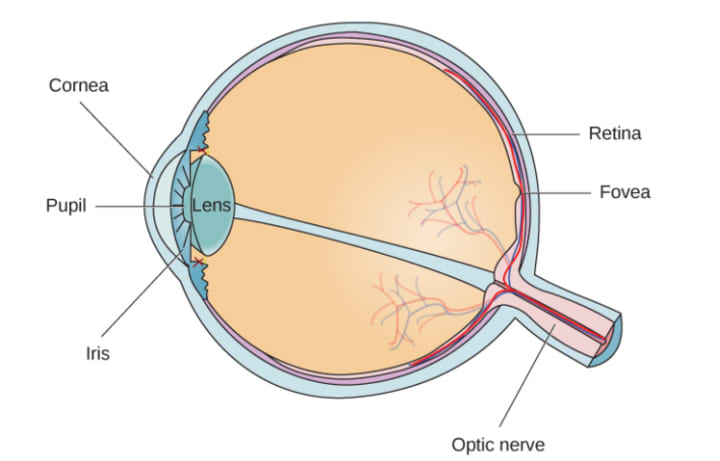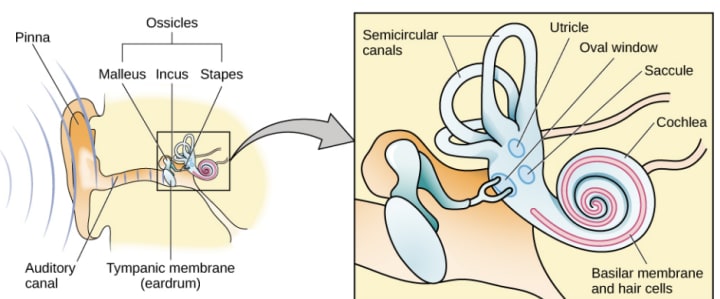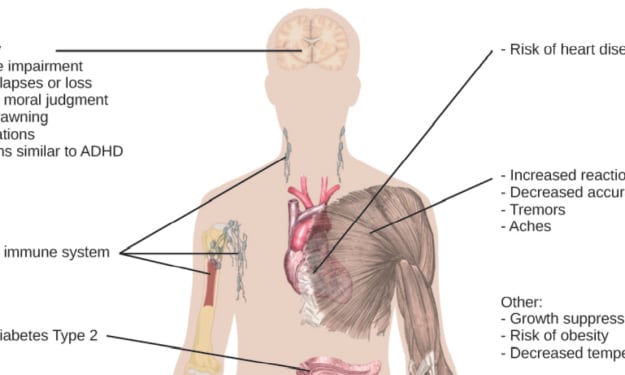Sensation & Perception 2
Psych 101 Part 2

Sound intensity is measured in dB decibels.
Higher pitched sounds have higher frequency and lower pitched sounds have lower frequency. Hz
Amplitude is measured by the volume of the sound. The louder it is the higher the amplitude. dB
Humans hear between 20 - 20000 hz. Dogs can hear between 70 -45000. This is why people say dogs have better hearing than humans.
Timbre - refers to sounds purity, which is affected by the complex interplay of frequency, amp, and timing of the sound waves.
--------------------------------------------------------------------------
The Visual System
The eye has a cornea which is a protective barrier between the pupil and the environment.
The pupil is a small opening in the eye that allows light to come in.
The iris is the part surrounding the pupil, those are muscles that are used to dilate the eye (open it more to receive light) or constrict (close to take in less light)
The lens is a curved muscle behind the pupil to provide additional focus on the image. It is attached to a large muscle that helps to directly reflect the image onto the Fovea.
The fovea is a small indentation in the back of our eye and it is part of our retina which is also connected to the optic nerve. The retina are nerves in the back of our eye.
cones and rods are small structures in our fovea. The cones help us see color and spatial resolution. The rods help us see light in dim settings and peripherally. Cones and rods are specialized photoreceptors.

Interneurons are connected to retinal ganglion cells which are also connected to the optic nerve and the optic nerve transmits these messages to the brain.
Optic nerves connect at the optic chiasm below the cerebral cortex and information from the left eye goes to the right brain and information from the right goes to the left brain.
Information is then sent to the occipital lobe located in the back of the brain via two parallels pathways call the "what" and "where/how" pathway. The what pathway is responsible for defining object recognition. The where/ how pathway defines location in space and its movement in space.
--------------------------------------------------------------------------
Normal sighted individual have three different types of cones in their eyes. Each of them are receptive to red, green, and blue, but each are maximally sensitive to different wavelengths of colors.
The trichromatic theory of color vision states that all color can be created from red green and blue.
Another theory that define color vision is the opponent process theory. The theory goes that one color excites the cell while another one inhibits it (wavelengths of course not the color itself).
---------------------------------------------------------------------------
3D vision happens when you use both of your eyes, called binocular disparity. The fusion of two different images to create a 3D image.
2D images happen when you use monocular cues that only require one eye.
Linear perspective refers to the fact that two parallel lines converge to an end points and objects are relative in size and closeness to horizon.
-----------------------------------------------------------------------
The pinnae is the outside of your ear. There is an auditory canal, a middle and inner ear and the tympanic membrane.
The middle ear has three small bones called the malleus, incus, and stapes.
The inner ear has semi circular canals used in the vestibular sense for balance.
The cochlea is a fluid filled snail shaped sack that contains (hair cells) sensory receptors.

Sound waves travel along the auditory canal and hit the eardrum (tympanic membrane.) This causes vibrations and causes the smaller bones move, the stape hits oval window and fluid inside of the cochlea begins to move. The hair cells (receptors) are embedded in the basilar membrane which is in the cochlea.
-------------------------------------------------------------------------
Share your ideas, notes, and stories with Vocal+
Theories on how sounds is decoded:
Temporal theory of pitch perception asserts that frequency is coded by the activity level of sensory neuron.
Place theory of pitch perception states that different portions of the basilar membrane are sensitive to different sounds of different frequencies.
Localization of Sound
Sounds locations are determined by interaural level difference (is it closer to the right ear or left ear?) and interaural timing difference (how long it takes to arrive at each ear.) This information is deciphered in the brain and constructs an image along a horizontal axis of where the sound comes from.
Hearing loss
- Congenital deafness - born deaf
- conductive hearing loss - problem with delivering sound energy to the cochlea.
- Sensorineural hearing loss - failure to transmit neural signals from cochlea to brain
Gustation
Five Groupings of Taste
- Sour
- Sweet
- Salty
- Bitter
- Unami (Japanese but translates to Yummy) (the flavor of monosodium glutamate/ fatty content)
Physical process of taste:
- Saliva dissolves food
- Taste buds are formed by groupings of similar taste receptors and their hair like extensions protrude into the central pore of a taste bud.
- The saliva interacts with these receptors.
- Neural information is then sent to the medulla, thalamus, limbic system and gustatory cortex which is between the frontal and temporal lobes.
Olfaction
Odor molecules bind with receptors that are in a mucous membrane at the top of your nose. They send signals to your olfactory bulb which is a bulb shaped structure on the tip of your frontal lobe and then information is sent to the olfactory cortex which is close to the gustatory cortex.

4 identified skin receptors:
- Meissner's corpuscle - receives pressure and low frequency vibrations
- Merkels disk - a skin receptor that receives low pressures
- Ruffini corpuscle - a skin receptor that receives detects stretching
- Pacinian corpuscle - receives pleasure and high frequency vibrations
Other nerves:
free nerve endings detect thermoception, and nociception (pain and potential pain).
these signals travel up the spinal cord to the thalamus, medulla and somatosensory cortex which is located in the postcentral gyrus of the parietal lobe.
Pain/ Nociception
- inflammatory pain - damage to tissue cells
- neuropathic pain - is when pain signals sent to the brain are exaggerated.
Vestibular & Proprioception and Kinesthesia
The vestibular sense is dictated by the utricle, saccule, and three canals (superior, posterior, and horizontal. These canals are filled with water and have hair like structures in them. These structures work with gravitational forces and position to send signals to the brain about balance.
Messages from the Vestibular sense, and receptors in our muscles, tendons, joints etc work together to help with our proprioception (perception of body position) and kinesthesia (perception of the bodys movement)
Gestalt Psych
- Law of proximity -- Law that states that we group things that are close to each other. EX: topics that are closer to each other are more similar than a paragraph at the beginning and end of this report.
- Law of Similarity - We group things that are similar. EX: if I use bold for all my vocabulary in this writing, you would know all of the bold words are vocabulary.
- Law of Continuity -- Which states that the mind is eager in completion of things or whole objects. EX:

Pattern perception is our ability to discriminate among different sensory stimuli.
Our perceptions are based off of perceptual hypotheses. Meaning that we make educated guesses interpreting sensory stimuli based on experience, knowledge, other information, personality, and other factors.
Please donate $1.00 to EZ College Notes, contact us on FB if you would like to see a certain topic, or if you have notes you would like to submit, you can do that as well!
About the Creator
EZ College Notes
We don't mince words here.






Comments
There are no comments for this story
Be the first to respond and start the conversation.